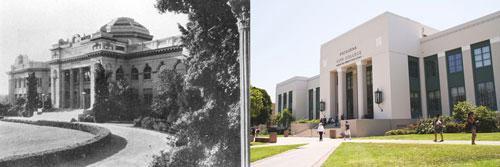The Horace Mann Building was the epitome of opulence for Pasadena Polytechnic High School.The building was unto itself a view, grabbing the gaze of onlookers from Colorado Boulevard to its seemingly meticulous attention to detail and craftsmanship.
Atop the structure’s sat a glass-coated dome that leaked in traces of sun into its vast hallways and kept the building in mood with the weather.
Acting as the structure’s arms and surrounding a curving landscape which made up a horseshoe-shaped courtyard were the Louis Agassiz Building to the east and the Jane Addams Building to the west.
In 1933, the Long Beach Earthquake brought all of this to its knees. The Sexson auditorium alone survived amongst the rubble and bore witness to the edification of the replacement C, E and D Buildings that would be the face of present day Pasadena City College.
“[Architecture] can stand for hundreds of years and it can tell people in the future about what was going on in the past and I think that’s an educational experience,” said professor of architecture Neiel Norheim.
“People can look at all these different buildings and they can see what was going on in different eras. It’s almost like learning history,” he said.
Norheim, who studied in Europe prior to landing at PCC, found that his strolls through the claustrophobic alleyways of European cities were to watch time slowly reverse its course and pedal forward seamlessly as he ventured further.
“Walking through these medieval streets was really gratifying in the sense that you would walk through them and you would feel as if you were walking through different periods of time,” said Norheim.
For Library Director Mary Ann Laun, who has been at PCC for 29 years, those medieval alleyways can be found snaking in and around the L Building, the site of the old campus library.
“I called the campus “urban ugly” because there was cement everywhere and where there wasn’t cement, there was ivy,” said Laun, recalling PCC’s own architectural dark age of the late seventies when landscape ran unchecked and vermin sprung at staff and students alike.
“Rats would come flying out of the ivy,” said Laun of a time before then vice president Dr. James Kossler started a campus beautification project in the mid 80’s.
The project’s focal point was to remap the landscape connecting each side of the campus and begin work on a two-part master plan, with the first ending in 2000 with the parking lot on Bonnie Avenue and again in 2010 with the completion of the new Center for the Arts.
The master plan also introduced a new style to the campus blueprint, that of the library aesthetic.
“The ornate architecture that was original to the [first] buildings was replaced with a far more austere, square, style,” said Director of Facility Services Richard van Pelt of the C, E, and D Buildings after the Long Beach earthquake.
“During the planning process for the new Library, the campus began its Renaissance. The Library took design cues from the [original buildings] without copying,” said van Pelt.
Motifs such as Shatford Library’s color tones and tall meshwork of outer windows became ubiquitous among modern additions such as Hutto Patterson Gym.
However, what made the Horace Mann Building so unique was that it stood apart from the surrounding architecture and evoked a unique response from the community. Whether or not the same can be said for a near homogenous campus is a topic of concern.
“The idea of cohesiveness in aesthetics when it comes to a campus is much the same issue of cohesiveness when it comes to a city or any sort of different architectural projects,” said Architect Professor Neiel Norheim.
“You think of a city as tapestry or a quilt of diff patches. If all those patches are the same you lose the value of the difference,” he said. “You lose part of that tapestry.”
At the end of the design process, as new faces of the campus are erected and stories embedded into their frames with each passing generation, how it impacts the community who make their lives at PCC is all the matters to Mary Ann Laun.
“I think the architecture inspires you, there’s no doubt in my mind. It inspires you to be your best while in that building,” said Laun.
In our old library, people didn’t want be in there,” she said. “We had cockroaches on the bottom floor, it was bad, pretty bad,” said Laun who now sits in a cockroach-free office in the Shatford Library.

The Horace Mann Building (left) prior 1933. The C Building (right) is built over its ruins. ((Left) Courtesy of Shatford Library, (Right) Elizabeth Piedra)
- EDITORIAL: Apologize about the real problem - April 23, 2014
- STATEMENT: District apologizes to Oscar winning alum - April 21, 2014
- EDITORIAL: The Forgotten Students - March 26, 2014
